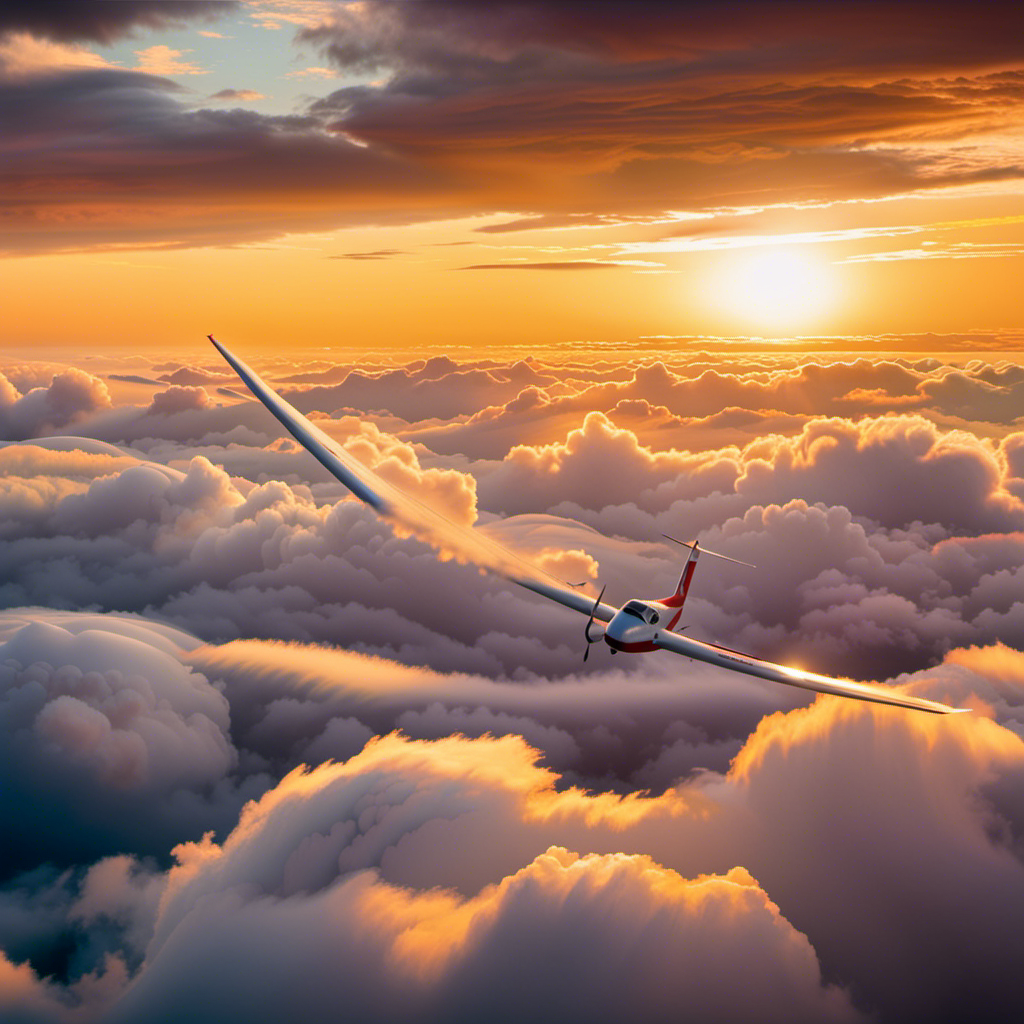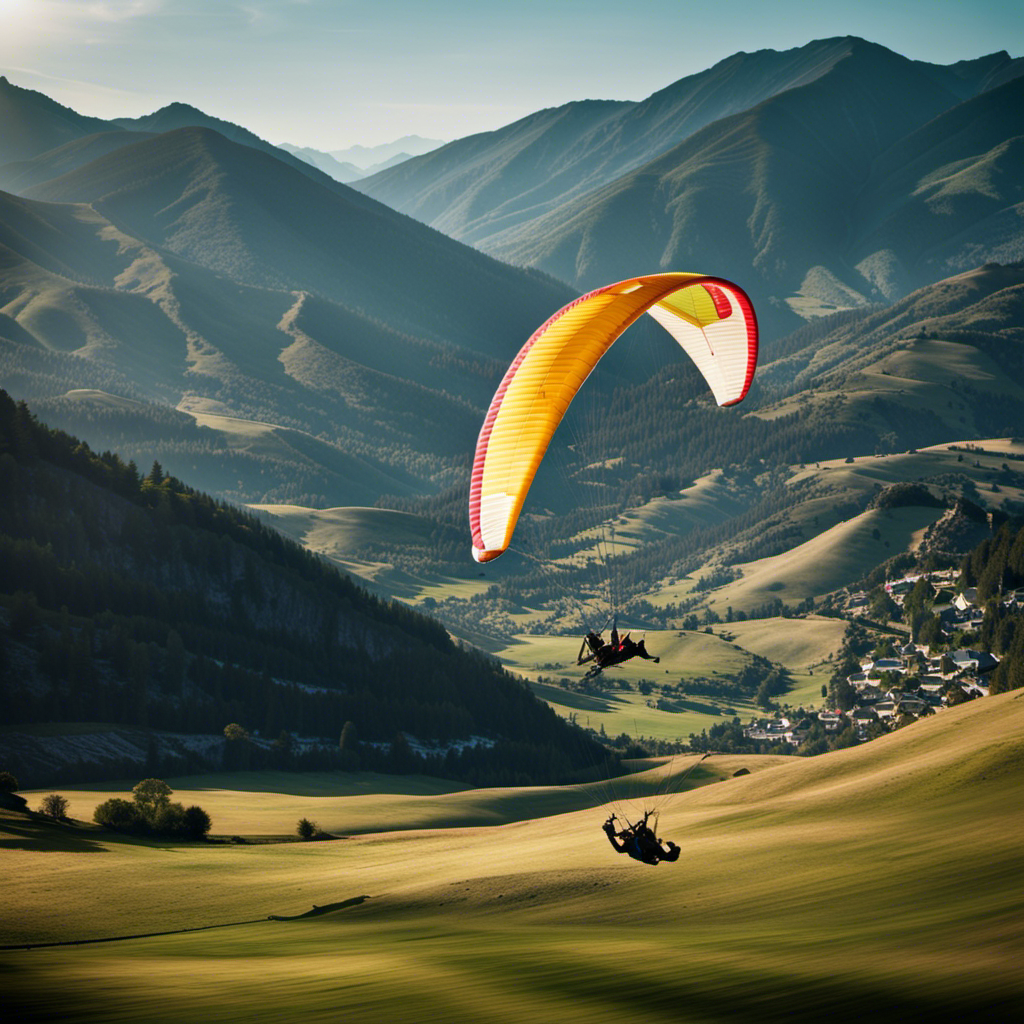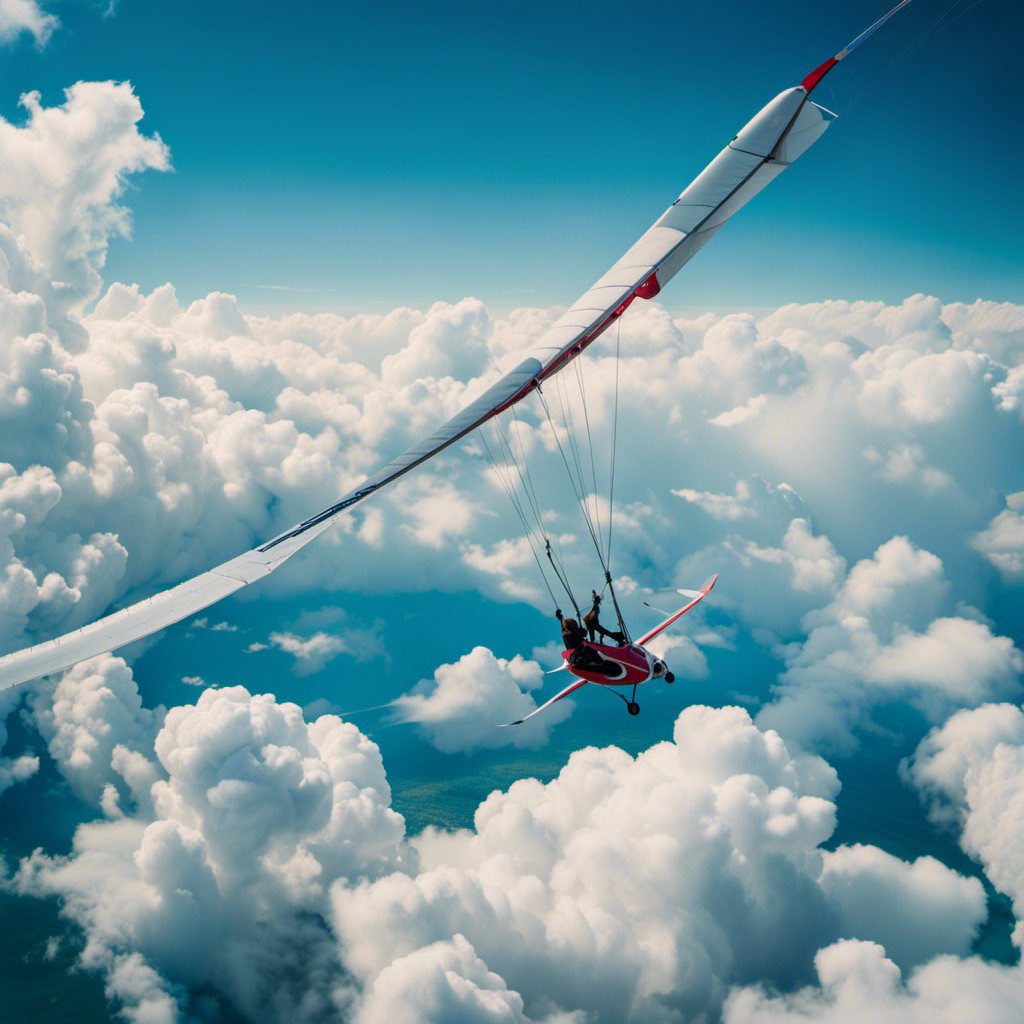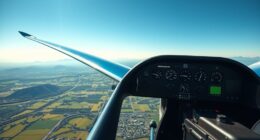As a glider pilot, I often wonder: can gliders glide above the clouds? This question sparks curiosity and fascination among pilots and aviation enthusiasts alike.
In this article, we will explore the science behind gliding, the ideal weather conditions for soaring above clouds, and the techniques and safety precautions involved.
Through personal stories and experiences, we’ll delve into the world of cloud soaring and discuss the future developments in this exhilarating form of flight.
So, fasten your seat belts and prepare for a journey above the clouds!
Key Takeaways
- Gliders can fly above clouds and utilize them for lift.
- Thermals and wave lift are essential for gliders to stay airborne.
- Skillful piloting and knowledge of weather patterns are crucial for gliding.
- Gliding above clouds offers enhanced visibility, smoother air currents, and extended flight times, but also presents challenges such as thunderstorms and altitude-related issues.
What is Gliding?
Gliding is a form of aviation that allows aircraft to fly without an engine. It relies on the natural forces of lift and gravity to keep the aircraft airborne.
The history of gliding can be traced back to the 19th century, with pioneers like Otto Lilienthal and the Wright brothers making significant advancements in the field. These early glider pilots paved the way for modern gliding and influenced the design and development of aircraft.
Today, gliding is a popular recreational activity and competitive sport, with famous glider pilots like Steve Fossett and Ewa Wiśnierska pushing the boundaries of what is possible in the air.
Understanding the science of gliding is essential to mastering this skill, which involves harnessing the power of rising air currents and utilizing aerodynamic principles to maintain flight.
The Science of Gliding
When it’s cloudy, you can still soar in the air using specially designed aircraft that take advantage of the principles of aerodynamics. Gliders, also known as sailplanes, are capable of flying above clouds and gliding for extended periods of time.
To understand how this is possible, let’s delve into the science behind gliding. The ideal gliding conditions involve specific cloud formations, such as cumulus clouds, which indicate rising columns of warm air known as thermals. These thermals provide the necessary lift for gliders to maintain altitude and even gain height. By skillfully maneuvering within these thermals, glider pilots can prolong their flights and cover great distances.
Now that we understand the science behind gliding, let’s explore the ideal weather conditions for this exhilarating sport.
Ideal Weather Conditions for Gliding
To make the most of your gliding experience, you’ll want to take advantage of specific cloud formations and rising columns of warm air known as thermals. These ideal weather conditions create the perfect environment for gliders to soar above the clouds.
When it comes to gliding above clouds, there are a few techniques that pilots employ. One technique is to search for areas of cumulus clouds, which indicate the presence of thermals. By flying near these clouds, gliders can ride the updrafts and gain altitude.
Another technique is to use ridge lift, which occurs when wind blows against a hill or mountain, causing the air to rise. By following the contour of the terrain, gliders can maintain altitude and potentially reach cloud level.
Soaring above clouds requires a deep understanding of weather patterns and strategic flying techniques. Now let’s explore some of these techniques in more detail.
Techniques for Soaring Above Clouds
When it comes to soaring above clouds, glider pilots have a couple of techniques up their sleeves.
One of them involves utilizing cumulus clouds for lift. These puffy white clouds can provide the necessary updrafts to keep the glider afloat.
Another technique is utilizing wave lift for high altitude flying. This occurs when wind encounters a mountain or other obstacle and creates a series of standing waves in the atmosphere, allowing gliders to ride the wave and gain altitude.
Using Cumulus Clouds for Lift
You can utilize cumulus clouds for lift when gliding above the clouds. This technique involves utilizing thermal updrafts created by these puffy, white clouds to gain altitude and maintain flight. It requires a deep understanding of cloud surfing techniques and the ability to read the sky for signs of thermals.
As a glider pilot, I have mastered the art of using cumulus clouds as a source of lift. By carefully positioning myself in the vicinity of these clouds, I can harness the upward air currents and extend my flight time.
However, there is another method for achieving high altitude flying called utilizing wave lift. This technique involves riding on waves of air created by the interaction of wind with obstacles such as mountains. This allows gliders to reach even greater altitudes without the need for thermal updrafts.
Utilizing Wave Lift for High Altitude Flying
Riding on waves of air created by the interaction of wind with obstacles, such as mountains, allows for achieving high altitude flying without relying on thermal updrafts. This technique, known as wave lift, is a key component of high altitude gliding.
Here are some important aspects of utilizing wave lift for high altitude flying:
- Wave lift is most commonly found downwind of a mountain range.
- Gliders can reach altitudes exceeding 30,000 feet using wave lift.
- The largest waves can extend for hundreds of miles, providing long-distance opportunities.
- Achieving and maintaining high altitude requires skillful piloting and knowledge of weather patterns.
Using these high altitude techniques, gliders have set impressive cloud soaring records, reaching incredible heights and covering vast distances. However, soaring above clouds comes with its own set of challenges and safety precautions.
Let’s explore these important considerations to ensure a safe gliding experience in the next section.
Safety Precautions for Gliding Above Clouds
Although it’s possible to glide above clouds, it is crucial to take safety precautions.
When flying above clouds, it is important to have a thorough understanding of safety measures to ensure a smooth and secure flight. Cloud formation plays a significant role in determining the safety of gliding above clouds.
It is essential to be aware of the type and density of clouds present, as well as any potential weather changes that may occur. Pilots must also be equipped with the necessary instruments and knowledge to navigate through clouds, such as utilizing radar to detect turbulence and icing conditions.
Benefits of Gliding Above Clouds
As a glider pilot, I understand the importance of safety precautions when flying above clouds. Now, let’s explore the benefits of gliding above clouds.
Gliding above clouds offers a unique experience that provides pilots with breathtaking views and a sense of freedom. Here are some techniques and benefits of gliding above clouds:
-
Enhanced visibility: Above the clouds, pilots have clearer visibility, allowing them to navigate more efficiently and safely.
-
Smooth air currents: Gliders can often find smoother and more predictable air currents above the clouds, resulting in a smoother flying experience.
-
Extended flight times: Gliding above clouds can provide longer flight times due to the reduced drag and lift generated by flying in clean, undisturbed air.
With these techniques and benefits in mind, let’s now delve into the fascinating gliding records and achievements pilots have accomplished in the history of glider aviation.
Gliding Records and Achievements
To fully appreciate the remarkable accomplishments in glider aviation history, you’ll be amazed by the numerous records and achievements that pilots have attained.
Gliding competitions have provided a platform for pilots to showcase their skills and set new benchmarks in the sport. From distance records to speed records, these competitions have pushed the boundaries of what is possible in glider flight.
The gliding world records are truly awe-inspiring, with pilots reaching incredible heights and covering vast distances solely on the power of the wind. These records not only demonstrate the skill and determination of the pilots but also highlight the incredible capabilities of glider aircraft.
As we delve into the world of gliding, it’s important to recognize the achievements that have paved the way for the exploration of famous gliding destinations for cloud soaring.
Famous Gliding Destinations for Cloud Soaring
Pilots can experience the exhilaration of soaring through clouds at famous gliding destinations. Cloud soaring offers a unique and thrilling experience for glider pilots, providing not only breathtaking views but also several benefits. Let’s take a look at some of the famous gliding destinations that are known for their ideal conditions for cloud soaring:
| Destination | Location | Benefits |
|---|---|---|
| Minden, Nevada | United States | Thermals and wave lift |
| Omarama, New Zealand | New Zealand | Wave lift and stunning landscapes |
| Bitterwasser, Namibia | Namibia | Strong thermals and long flights |
At these destinations, pilots can take advantage of thermals and wave lift, which enable them to reach impressive altitudes and stay airborne for extended periods. The benefits of cloud soaring include increased lift, improved visibility, and the opportunity to explore new and diverse flying conditions. However, gliding above clouds also poses challenges and risks, which we will explore in the next section.
Challenges and Risks of Gliding Above Clouds
As a glider pilot, I’m well aware of the challenges and risks associated with flying above clouds.
One of the key points to consider is the potential for encountering thunderstorms and turbulence. These weather phenomena can pose significant dangers to gliders, as they can cause sudden changes in wind direction and intensity.
Additionally, the altitude at which gliders operate can present oxygen and altitude challenges, which can impact both the pilot’s performance and well-being.
Thunderstorms and Turbulence
Flying in thunderstorms can be extremely dangerous, so it’s important for pilots to avoid them whenever possible. Thunderstorm avoidance is a critical aspect of safe flying, as these powerful weather systems can produce severe turbulence that can greatly impact the stability and control of an aircraft.
Turbulence caused by thunderstorms can lead to sudden and violent changes in airspeed, altitude, and attitude, making it challenging for pilots to maintain control of the aircraft. Additionally, the strong updrafts and downdrafts associated with thunderstorms can cause significant changes in altitude, posing a risk of collision with other aircraft or obstacles.
Therefore, pilots must carefully monitor weather conditions and make informed decisions to steer clear of thunderstorms to ensure the safety of their flight.
Now, let’s explore the next challenge that glider pilots face, which is the combination of oxygen and altitude challenges.
Oxygen and Altitude Challenges
To tackle the oxygen and altitude challenges, you’ll need to acclimate your body to the thin air at higher elevations. High altitude training is essential for glider pilots who want to perform at their best in these conditions.
One of the main concerns at high altitudes is the decrease in oxygen supply. As you ascend, the air becomes thinner, making it harder for your body to get the necessary oxygen it needs. This can lead to symptoms like dizziness, fatigue, and even altitude sickness.
To combat this, glider pilots undergo specific training to increase their oxygen supply and adapt to the lower oxygen levels. By gradually exposing themselves to higher altitudes, they can condition their bodies to function optimally in these conditions.
Transitioning into the subsequent section about gliding communities and competitions, it is within these tight-knit communities that glider pilots share their knowledge and experiences, pushing the boundaries of gliding to new heights.
Gliding Communities and Competitions
You can find vibrant gliding communities and competitive events happening all around the world. Gliding enthusiasts come together to share their passion for this exhilarating sport and showcase their skills in various gliding techniques. Competitive gliding involves pilots competing against each other in races, aerobatic maneuvers, and precision landings. These events not only promote friendly competition but also provide an opportunity for pilots to learn from each other and improve their gliding abilities. To give you a glimpse into the world of gliding communities and competitions, here is a table showcasing some of the major events happening globally:
| Event | Location | Date |
|---|---|---|
| World Gliding Championship | Australia | Nov 2023 |
| European Gliding Championship | Poland | July 2022 |
| National Gliding Championship | United States | Aug 2021 |
| Asian Gliding Championship | Japan | Oct 2022 |
| South American Gliding Championship | Argentina | Sept 2022 |
Now that we have explored the vibrant gliding communities and competitive events, let’s delve into the fascinating world of gliding equipment and technology.
Gliding Equipment and Technology
The advancements in gliding equipment and technology have revolutionized the sport, allowing pilots to achieve greater precision and control during their flights. With the continuous development of gliding technology, pilots now have access to state-of-the-art equipment that enhances their flying experience. Here are five key advancements in gliding equipment:
- Improved wing design: Modern gliders are equipped with wings that have been optimized for efficiency and performance, allowing pilots to stay airborne for longer durations.
- Advanced cockpit instruments: Pilots now have access to advanced instruments that provide them with real-time information on altitude, airspeed, and wind conditions, enabling them to make more informed decisions during their flights.
- Enhanced safety features: Gliders now come with improved safety features, such as ballistic recovery systems and advanced avionics, ensuring the well-being of pilots in case of an emergency.
- Lightweight materials: The use of lightweight materials, such as carbon fiber composites, has significantly reduced the overall weight of gliders, resulting in improved maneuverability and fuel efficiency.
- Integrated telemetry systems: Gliders are now equipped with integrated telemetry systems that allow pilots to gather and analyze data during their flights, helping them to optimize their performance and make adjustments as needed.
These advancements in gliding technology have undoubtedly transformed the sport, enabling pilots to push the boundaries of what is possible in the air.
However, when comparing gliding to powered flight, there are distinct differences that make each unique.
Gliding vs. Powered Flight
In comparing gliding and powered flight, it is important to consider the differences in experience and skill required for each.
Gliding requires a deep understanding of aerodynamics and the ability to read and interpret natural forces. It involves relying on the wind and other natural elements to stay aloft. The glider pilot must be skilled at finding and utilizing updrafts and thermals to maintain altitude and extend flight time.
On the other hand, powered flight involves the mastery of complex systems and the ability to control the aircraft in all phases of flight. It requires knowledge of engines, fuel systems, and navigation instruments. The pilot must be able to manage the power and control settings to maintain safe and efficient flight.
There are advantages and limitations to both types of flight. Gliders have the ability to stay aloft for extended periods of time, as long as there are favorable weather conditions and enough natural lift available. They offer a unique and peaceful flying experience, with minimal noise and a sense of freedom.
Powered aircraft, on the other hand, offer more versatility and flexibility. They can take off and land on their own, allowing pilots to fly to specific destinations and cover longer distances. However, powered flight comes with higher costs, including fuel and maintenance expenses. It also has a greater environmental impact due to the emissions produced by the engines.
Differences in Experience and Skill
It’s important to understand the differences in experience and skill when it comes to flying gliders above clouds. In this unique aviation realm, experience levels vary greatly, impacting safety measures and overall success. Here are three factors to consider:
-
Experience levels: Pilots with extensive gliding experience possess a deep understanding of glider dynamics and meteorology, crucial for safely navigating above clouds. Novice pilots, on the other hand, may lack the necessary knowledge and decision-making skills, making it riskier for them to venture into this environment.
-
Safety measures: Gliding above clouds requires meticulous planning and adherence to safety protocols. Experienced pilots prioritize thorough pre-flight checks, constant monitoring of weather conditions, and effective communication with air traffic control. These measures mitigate potential risks and ensure a safer flight.
-
Mental resilience: Flying above clouds demands a strong psychological mindset. Experienced pilots have honed their ability to handle the isolation and limited visibility that it entails. They remain calm and focused, making informed decisions under challenging circumstances.
Understanding these differences in experience and skill is crucial for appreciating the advantages and limitations of flying gliders above clouds.
Advantages and Limitations
Consider the advantages and limitations of piloting gliders in a cloud-filled sky.
Gliding above the clouds offers several advantages for pilots. Firstly, it provides an opportunity to soar in smooth air, away from the turbulence commonly experienced closer to the ground. This allows for longer flights and the ability to cover greater distances. Additionally, flying above the clouds offers breathtaking views and a sense of serenity and freedom.
However, there are also limitations to consider. Gliders rely heavily on visual cues for navigation, and flying in a cloud-filled sky can greatly reduce visibility, making it difficult to maintain situational awareness. Furthermore, clouds can pose a risk of icing, which can affect the performance and control of the glider.
Despite these limitations, the allure of cloud soaring and the unique experiences it offers continue to captivate glider pilots.
Personal Stories and Experiences of Cloud Soaring
As a pilot, I’ve had the privilege of experiencing breathtaking flights and embarking on thrilling adventures that have left a lasting impression on me.
From soaring through the clouds to navigating challenging weather conditions, each flight has provided unique insights and perspectives on the world from above.
These memorable experiences have not only deepened my understanding of aviation but have also enriched my personal growth as a pilot.
Pilots’ Perspectives and Insights
Pilots often share their perspectives and insights on whether gliders can fly above clouds. As a glider pilot myself, I have encountered various challenges when it comes to soaring above cloud layers.
One of the main challenges is the unpredictable weather patterns. Clouds are often associated with turbulence, which can make it difficult to maintain control and stability in the air. Additionally, flying above clouds requires careful planning and navigation to avoid potential hazards, such as icing or reduced visibility.
However, with the right skills and knowledge, it is possible to safely fly above clouds and enjoy the breathtaking views that lie beyond.
Transitioning into the subsequent section about memorable flights and adventures, I have had the privilege of experiencing some truly remarkable moments in the sky.
Memorable Flights and Adventures
In my years of flying gliders, I have had the privilege of experiencing some truly memorable flights and adventures. Here are three that stand out:
-
Soaring above the majestic mountain ranges: Gliding through the valleys and peaks of towering mountains provides a breathtaking view and a sense of awe-inspiring freedom.
-
Flying with the birds: Sharing the airspace with birds is a surreal experience. Gliders are silent and nimble, allowing us to blend seamlessly with nature and witness the world from a unique perspective.
-
Cross-country exploration: Gliding allows for long-distance flights, where we can travel vast distances with only the power of the wind. It’s a thrilling challenge to navigate and strategize the best route, maximizing the use of thermals and updrafts.
While these adventures bring immense joy and satisfaction, they also come with their fair share of challenges. Adverse weather conditions, limited endurance, and the constant need for situational awareness are just a few of the hurdles we face. However, the benefits of gliding, such as the pure tranquility and the ability to explore the skies without an engine, far outweigh these challenges.
As gliding continues to evolve and advance, future developments hold exciting possibilities. From improved aerodynamics and materials to enhanced safety systems and navigation technology, the future of gliding promises even greater adventures and opportunities for pilots to push the boundaries of what is possible in the sky.
Future Developments in Gliding
There’s potential for exciting advancements in gliding in the future. As technology continues to evolve, gliders are poised to benefit from future innovations that will revolutionize the sport. These advancements will not only enhance the performance and safety of gliders, but also minimize their environmental impact.
Here’s a glimpse into what the future of gliding may hold:
| Future Innovations | Environmental Impact |
|---|---|
| Improved Materials | Reduced Carbon Emissions |
| Advanced Avionics | Minimal Noise Pollution |
| Electric Propulsion | Lower Energy Consumption |
| Autonomous Systems | Decreased Wildlife Disturbance |
With improved materials, gliders will become lighter and more durable, allowing for greater maneuverability and efficiency. Advanced avionics will provide pilots with enhanced navigation and communication systems, ensuring safer and more precise flights. Electric propulsion systems will reduce the reliance on fossil fuels, resulting in lower carbon emissions and a smaller environmental footprint. Autonomous systems will enable gliders to fly more efficiently and autonomously, further reducing energy consumption.
Conclusion and Final Thoughts on Gliding Above Clouds
With the potential for improved materials and advanced avionics, the future of gliding above clouds holds promise for enhanced capabilities and a more exhilarating experience. As an experienced glider pilot, I have witnessed the benefits of cloud soaring firsthand.
Here are some key points to consider:
- Increased altitude: Gliding above clouds allows for reaching higher altitudes, providing access to stronger and more consistent thermals.
- Extended flight duration: By utilizing the energy from the thermals above clouds, gliders can stay aloft for longer periods, pushing the limits of endurance.
- Enhanced visibility: Gliding above clouds offers breathtaking panoramic views, allowing pilots to appreciate the beauty of the sky and surrounding landscape.
While cloud soaring offers numerous advantages, it is crucial to prioritize safety when engaging in high altitude gliding. Here are some safety precautions to keep in mind:
- Proper oxygen supply: At high altitudes, the air becomes thin, making it essential to have a reliable oxygen system for both the pilot and passengers.
- Weather monitoring: Cloud formations can change rapidly, so it is crucial to stay updated on weather conditions and be prepared for any sudden changes.
- Adherence to regulations: It is important to follow aviation regulations and guidelines when gliding above clouds, ensuring a safe and responsible flight.
Frequently Asked Questions
Can gliders fly in all types of weather conditions?
No, gliders cannot fly in all types of weather conditions. Gliding in rain is not recommended as it can affect the aerodynamics and visibility of the glider. Gliding in strong winds can also be dangerous and challenging.
What are some common safety precautions for gliding above clouds?
When gliding above clouds, it is crucial to prioritize safety. Proper gliding equipment, such as oxygen systems and instruments, should be used. Familiarity with different cloud formations is essential for navigating and avoiding potential hazards.
Are there any specific techniques or strategies for soaring above clouds?
When soaring above clouds, it is essential to employ specific strategies and techniques. These may include optimizing lift sources, such as thermals or ridge lift, and utilizing cloud streets and convergence zones to maintain altitude and navigate effectively.
What are some notable gliding records and achievements related to cloud soaring?
Notable gliding competitions include the World Gliding Championships and the European Gliding Championships. Cloud soaring offers benefits such as extended flight duration and access to strong thermals.
Are there any famous destinations known for their opportunities for gliding above clouds?
Famous destinations like the Andes Mountains and the Sierra Nevada offer exceptional opportunities for gliding above clouds. These regions have hosted numerous gliding records due to their favorable weather conditions and high-altitude terrain.
Conclusion
As I soar above the fluffy white clouds, I can’t help but feel a sense of awe and wonder.
Gliding above the clouds is not just a physical experience, but a symbol of freedom and liberation.
It represents the human desire to reach new heights, both literally and metaphorically.
The science and techniques behind gliding above clouds are fascinating, but it is the emotion and symbolism that truly captures the imagination.
Gliding above the clouds is not just flying, it is chasing dreams and defying limitations.
With a heart that soars as high as the skies, Aria, affectionately known as “Skylark,” is the driving force behind Soaring Skyways. Her journey into the gliding world began as a young dreamer gazing up at the soaring birds, yearning to experience the weightlessness and freedom they embodied. With years of experience both in the cockpit and behind the scenes, Aria’s commitment to the gliding community is unwavering.










